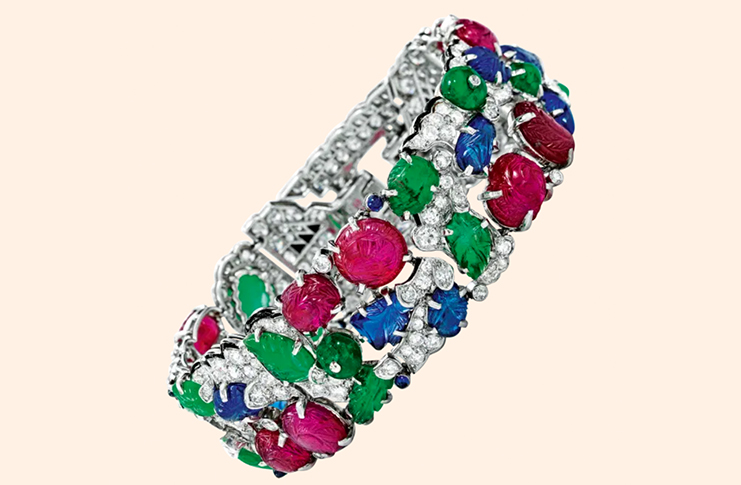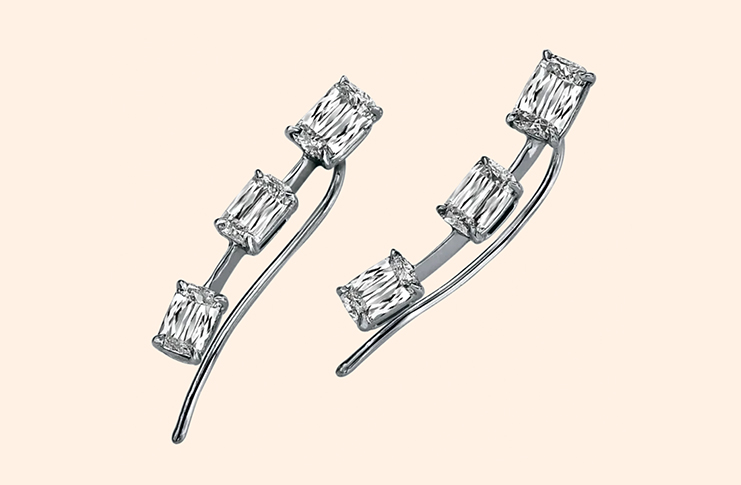At the end of April, while you were waiting for an Ocado slot to secure flour for your sourdough, another eager consumer was holding their nerve at sothebys.com. They placed a final bid of $1.34m for a 1930s Cartier Tutti Frutti bracelet – an Indian-inspired art deco classic, clustered with carved gems. In doing so, they set a record for the highest price ever paid for a jewel online.
It was a short-lived record, as it turned out. At the Christie’s online jewellery auction at the end of June, an emerald-cut 28.86ct D-colour type-IIA diamond (chemically pure, with limpid beauty) went for $2.1m. During the sale, Christie’s reported unprecedented digital engagement across 134 countries, with a 70 per cent increase in daily visitors to the sale page compared with its online jewels sale in June of 2019. Sotheby’s, too, reported that jewellery had proved to be one of the bestselling categories online since the pandemic began: in April, five in 10 of the most valuable lots sold online were jewels. Both auction houses had attracted a slew of new buyers – more than 30 per cent of attendees – to online jewellery sales. They had been quick off the mark in moving sales online, and in the process sparked an interesting moment – and momentum – for their corner of the luxury world.

As uncertainty rippled across the globe, jewellery showed signs of reverting to one of its most essential roles: a safe haven and store of wealth in times of crisis.
Jewellery and its intrinsically valuable components, namely gold and gemstones, stood out again – representing security, stability, longevity and continuity. In light of the global economic turmoil, they also offered the potential of an alternative asset class. Coupled with these “hard” values were the purely joyous properties of jewels: they’re uplifting, life-enhancing, escapist, unlikely to go out of style next season – something to be enjoyed impulsively and viscerally, or savoured and studied during our incarceration.
Graeme Thompson, worldwide head of jewellery at auctioneers Phillips, notes: “During the pandemic, discretionary spending has shifted away from luxury holidays, couture and high-end accessories to jewellery, diamonds and gemstones as a store of wealth, a hedge against possible inflation, an undeniable mood-lifter and a memento that can be passed down.” Gemstones are a store of wealth – and an undeniable mood-lifter” Graeme Thompson, worldwide head of jewellery at Phillips While there have been definite shifts in what – and how – consumers are buying, the pandemic has also crystallised emerging or evolving market trends. As the online auction records proved, the classics – your signed Cartier jewels or top-quality diamonds – have done well online because as well as having enduring appeal, they’re identifiable and quantifiable (so can be assessed online without seeing them up close and in-person). While prices of white diamonds had flattened, the crisis seems to have reinvigorated interest. Alisa Moussaieff, of Moussaieff Jewellers, who bought a rare, shield-shaped 100ct diamond for £4.7m at Christie’s Geneva in July, sees buyers “slowly waking up to white diamonds and beginning to nibble”. She believes it’s because “people have the time to watch and study”.

Meanwhile, Saul Goldberg, of New York diamantaire William Goldberg, has seen demand grow for higher-value diamonds. More noticeable is the quest for significant coloured gemstones, especially gems from the great heritage mines in Kashmir, Myanmar (formerly Burma) and Colombia, and, rarest of all, coloured diamonds. “Top pink and blue diamonds – as well as Burmese rubies, Kashmir sapphires and Colombian emeralds with no oil – are the gems that are leading the interest of investors into our industry,” notes Albert Boghossian, CEO of the eponymous Geneva-based house.

Supply of these heritage gems is limited at the best of times but, Boghossian explains, “cutters, dealers, auctions were all either shut down or unable to operate normally – hence, production was reduced to a trickle of what it was.”
At 1stdibs, jewellery specialist Clive Kandel has seen a rush for single-stone rings set with an emerald, ruby or sapphire (particularly where the origin of the stones can be identified), and rings set with old mine-cut diamonds from around 1900. Origins and history, as ever, make for interesting talking points and add narrative and a sense of connoisseurship. “The ring is back to being the most visible item of jewellery,” he says. The ring is also the jewel that women can enjoy for themselves. With no events or occasions to dress up for, we’ve been buying more jewels to wear at home for personal pleasure. For Eve Goldberg of William Goldberg, “it’s less about showing off and more about jewellery with a cool factor for yourself – to make you feel good, wear every day, to dance around the house.” She cites its bestselling diamond sautoir, or ear cuffs. “Jewellery fashion was going in that direction before the pandemic,” she says. “Now the situation has accelerated.”
Ara Vartanian paraíba tourmaline, white-diamond and 18ct-white-gold necklace, Heightened emotions during the crisis mean that sentiment has become inscribed in the lore of the lockdown jewel. Heartfelt designs are rivalling – even overtaking – the talismanic, as buyers are drawn to the emotional essence of the jewel, its ability to create memories, mark milestones and celebrate relationships. At Dior, Victoire de Castellane expanded her self-empowering Oui collection of delicate little tracery-type jewels of looping gold script, like a golden thread. Capturing the mood of the moment, she has added “Je t’aime” and “Toi, moi” to celebrate relationships – between mothers and daughters, sisters, and even with ourselves – that have been thrown into such high relief.
Brazilian designer-jeweller Ara Vartanian says jewels set with tourmalines and emeralds from three small-scale Brazilian mines have been particularly in demand. “Couples not spending money on travel or restaurants have a budget to spend on jewellery to gift to each other.” Crisis or no, birthdays, anniversaries, births and proposals have come along, as usual, adds Chaumet’s CEO Jean-Marc Mansvelt. Their Bee My Love rings have been especially popular, as well as engagement rings and the Jeux de Liens Harmony medallions, made to be engraved on the reverse with messages of love and hope (the Liens cross-stitches symbolise connection and commitment, ties of love, friendship and affection). “Our perception is that there is a desire to cling to something tangible,” he says. The quest for something solid, enduring and immutable has also accelerated the trend away from all things skinny, minimal and linear towards far more substantial, maximalist jewels, especially in gold.
Not only does 18ct gold have intrinsic value, says Annoushka Ducas, founder and creative director of boutique brand Annoushka, however, it also possesses warmth, tactility, sensuality and a reassuring weightiness. She particularly loves the way in which gold takes on a personal patina. “Gold has its own story, and in 100 years it will still have those memories and that narrative.”
Before the pandemic, jewellers were preoccupied with the challenge of making high and fine jewellery relevant to a generation that was generally less materialistic, more concerned with experiential purchases such as travel, and with forging its own personal milestones. Now those younger buyers are coming to appreciate jewels, with their multiplicity of meanings.
According to Sotheby’s, 25 per cent of its online bidders between January and July were aged 40 and under. Annoushka has also witnessed an increase in the number of younger clients. “Online, we’ve seen a 25 per cent increase in transactions by 25- to 35-year-olds, which is now our fastest-growing age group. On Instagram, where we know our customer is younger, we’ve seen traffic to the site increase by 281 per cent year on year.”


While the auction houses have given traditional jewellers a run for their money, they’ve also pushed a whole industry – which is generally conventional – to become more creative and to make the jewellery experience more engaging and relevant to a younger clientele. Michael Wainwright, Boodles’ managing director, says: “While online purchases were rather ‘transactional’ pre-lockdown, we are now seeing this channel as a real opportunity to find new customers and bring them into the Boodles fold.” In this sense, there’s positive change afoot. Chaumet’s Mansvelt believes the search for “authenticity, long-lasting brands, real stories and heritage may lead to a less frenetic, more considered, fully conscious consumption”. It’s a concept driven by a generation that is also making the pursuit of individuality, artistic expression and knowledge its hallmark. Ida Faerber, of Thomas Faerber antique and gemstone merchants, hopes this will open up creative possibilities and push jewellery to be viewed as art. “A moment of crisis is also a moment of opportunity,” she says. “Knowledge will be everything – it is the essence of the future.”
Source: FT.com
![]()









